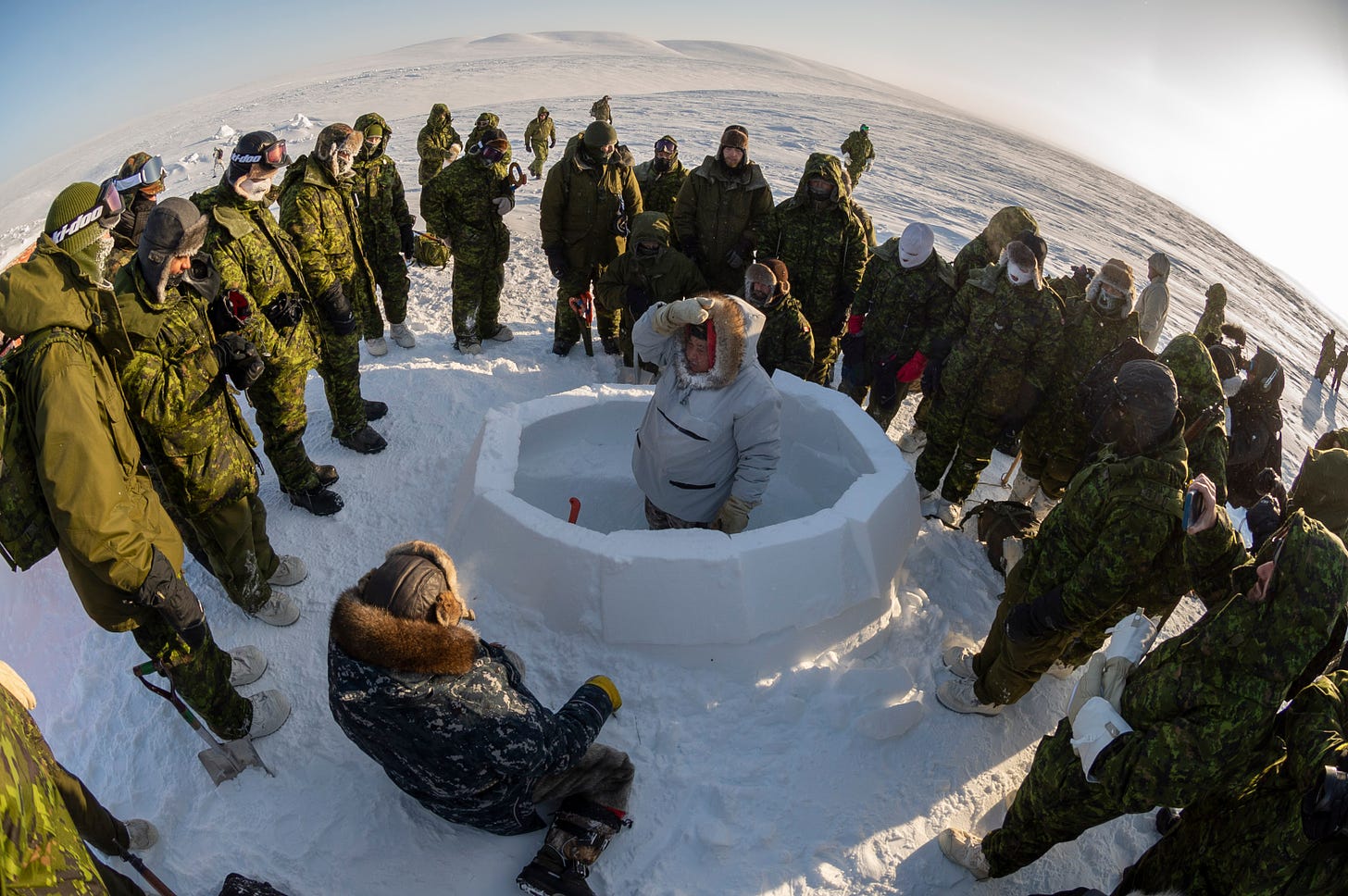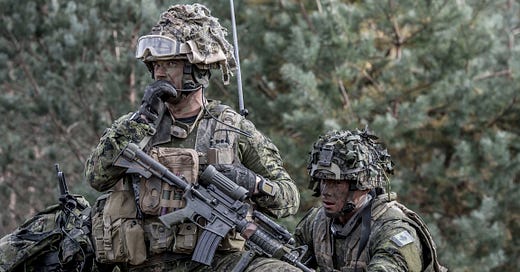Lesson 3: Canada should learn to fight like Ukraine
Canada's Rangers provide an example to build on. Choosing the right F-35 now key.
As a small nation occupying a vast landscape, Canada is unable to defend itself against a much larger aggressor. And, by virtue of being surrounded by three of the five largest oceans on Earth, only a much larger aggressor could conceivably invade Canada.
Canada’s first line of defence is diplomacy: maintaining peaceful relations with its neighbours and those nations capable of doing it harm. Failing that, Canada has two primary national defence strategies. The first is to build and maintain strong alliances for collective defence with other nations. This, Canada has done for most of its existence.
The second strategy is one Canada has not pursued since the War of 1812. It’s time we picked it up again: Canada must learn how to prepare for war like Finland and, if one comes, to fight like Ukraine.
Prepare like Finland
Like Canada, Finland is a small nation that lives in the shadow of a global giant. Both nations share a frontier with Russia, although Canada’s frontier is buttressed by the Arctic Ocean. The Russian army can drive into Finland. For that reason, Finland takes its national defence seriously, even though it can’t afford more defence than Canada can.
Canada can and should learn much from the Finns about how they build defence considerations into all their public and private infrastructure as well as the daily fabric of their lives. That’s a topic for another column, but the Financial Times provides a very good primer here.
Fight like Ukraine
Ukraine is being attacked by a much larger, better armed force that is all but unstoppable. Yet, they’ve largely stopped the Russians in many areas. How?
The Ukrainians turned the tables on Russia by fighting on their own terms. They are not attacking Russian forces head-to-head where they would certainly lose. Instead, they’re operating as an irregular force, in small groups, to draw the Russians into traps in cities and towns, then attack them from the sides, picking off commanders and enough tanks to create obstacles the Russians must then manouevre around. The Ukrainian air force live on, flying its fighters from obscure airfields, hidden bases and rural highways. Although it’s a bloody gruesome war, the Ukrainians can keep this up as long as their ammunition holds out.
Canada needs to learn how to do this. It’s the only way we could fight an enemy landed on our shores. And, it’s a vital contribution that a small Canadian army could provide to our NATO allies in future conflicts. Leave the massive combined arms manoeuvring to the US, UK, France and Germany. Canada could specialize on special operations – being a pesky, annoying, indefatigable nuisance that bogs the enemy down while the bigger boys swoop in to destroy them.
Only the largest of militaries could land troops in force on Canadian soil by air, land or sea. So, by default, any invasion of Canada would be an asynchronous war: a small Canadian force battling a much larger, better equipped invader. So, Canada’s military should plan and train to fight like Ukraine on home soil. Yet, we don’t do this.
Fighting like Ukraine means ensuring our army is trained, equipped and pre-positioned to fight in small, isolated groups operating independently. The good news is Canada’s military already does this – for lack of funding. Our generals should seize the opportunity to develop this reality as a strength.
Canada’s Rangers lead the way
From 1988 to 1991, I was the regular force Adjutant to a reserve infantry regiment – The Rocky Mountain Rangers – based in Kamloops, B.C. The unit numbered between 80 and 130 part-time soldiers supported by a cadre of four to five regular force members.
Like most reserve infantry units of its time, the Rangers were tasked to train soldiers in dismounted infantry tactics in order to generate individual augmentees for the regular army when needed, and as a basis for mobilization in the event of war. The war time scenario assumed reserve units would be called up to serve as formed units, fleshed out with hurriedly trained wartime recruits. As a scenario to mobilize for the First World War it was outstanding. As a plan for then 20th – now 21st – Century warfare it was always ridiculous.
The Rangers were the only army unit in Kamloops and Kamloops too far away from other units to train collaboratively very often. With only a platoon or two of troops on the roster, training them for line infantry operations was challenging. The unit was funded for about two dozen training days a year, and line infantry soldiers must be able to perform myriad combat-related tasks with excellence. Canadian army doctrine also never envisions individual platoons doing anything alone, ever. So training for line infantry operations was all but impossible.
What the Rangers could do, however, was train smaller teams of four to five soldiers in highly specialized roles. The Rangers proposed reconnaissance (the Canadian army calls it “recce.”) which was a narrow task normally reserved for experienced soldiers in regular infantry battalions. But, even those full-time regulars rarely spent more than a month a year doing actual reconnaissance training. The rest of their time was focused on mastering general infantry skills, advancing their technical knowledge on weapons and equipment that isn’t necessary for recce operations and maintaining all the expensive kit and equipment required by a modern mechanized/motorized infantry battalion.
The army already recognized reserve soldiers would need extensive up-skilling before they could be employed full-time when augmenting regular army units for peacekeeping and war fighting deployments. So, allowing the Rangers to focus their training on recce operations wouldn’t cost the army anything. And, it would develop a critical capacity that could actually be used day-to-day if asked.
The Rangers did most of their training in small numbers in the countryside surrounding Kamloops. As they trained, they learned the local topography – precisely the kind of knowledge they would need if called on to degrade and defeat an invader. Had there been a plan, they could have purposefully developed much more detailed knowledge of B.C.’s interior country. They could have learned to “Ukraine” the hell out of any enemy that sought to capture and hold land in B.C.
Canada’s entire army is like the Rocky Mountain Rangers. Purely for budget reasons, our small army is penny-packeted in small groups across the country. They rarely train in large groups. Battalion commanders are accustomed to operating independently with little oversight. They learn to train in local areas. All of this is seen as a weakness by army planners. But, in a Ukraine war scenario, these weaknesses become strengths. It’s time we followed age-old military advice and reinforce our strengths.

Our high north is “guarded” by Canadian Rangers – who have little or no similarity to their Rocky Mountain counterparts beyond also being officially members of the army reserve. In reality, Canadian Rangers are not soldiers. They’re hunters and farmers with minimal military training, who socialize together in small groups scattered across the north. Because they hunt for a living, these rangers know how to handle a rifle. Their uniform is a red baseball cap and a hoodie, both emblazoned with the Canadian Rangers logo. The government issues them with a rifle (formerly a WW1 issue Lee-Enfield rifle, currently being replaced with a sexy new, modern hunting rifle) and an annual allotment of ammunition for hunting. It’s a cheap way to ensure the rangers maintain their marksmanship skills and survival tradecraft.
The Canadian Rangers program is the cheapest way to sustain eyes and ears on the ground in the Arctic. These men and women are expected to keep us informed of what’s happening up their. They’re not equipped, trained or expected to fight (although, I’m sure they would!) They are expected to guide regular Canadian soldiers parachuted (literally or figuratively) into the north in the event of an incursion or disaster.
Just as these northern rangers are expected to develop detailed expertise about local topography, wildlife and weather, all Canadian military units – especially our isolated reserve units – should be tasked to do the same. Imagine how valuable a detailed knowledge of logging roads, lakes, mountain tops, challenging and impassable terrain and local habitation would be in the event of an armed incursion – or natural disaster, major air crash or other emergency. Yet, Canada has no such plan to develop this potential invaluable resource that already exists, but is allowed to wither on the vine. This must change. Now is the time to do so.
Canada now needs to choose the right F-35 variant
Canada announced this week it would acquire the F-35 Joint Strike Fighter to replace its aged fleet of CF-18s. That’s the right decision. But, there are different variants of the F-35, as there were for the F-18. In Ukraine, its small air force continues to bring harm to Russia’s invading horde long after it was expected to be a non-player. They’ve accomplished this by operating aircraft from small, remote airfields and makeshift runways on farmer’s fields and stretches of rural highway.
Canada’s new F-35 fighters should be able to hide and launch from small clearings in the woods, unserviced runways in the far north and short stretches of mountain highways where they would be well-hidden from a bigger, more capable adversary. This means we should buy the more expensive short/vertical take off version of the F-35.
Yes, the chances of an armed incursion on Canadian soil is small. But, ignoring the possibility completely is negligent. Fortunately, the same skills we should be developing for homeland defence are also extremely valuable when we send troops abroad to join larger coalitions. When we do that, we call those special operations skills. And, they’re cool. Let’s make them cool at home too.
Come back tomorrow for Lesson 4: Canada must admit it needs a military that can kill people.





This lesson #3 is nonsensical.
Finland isn't a NATO member and they share a border with Russia. Russia/USSR invaded them 80+ years ago and stole 10% of their land from them (for security reasons). Sounds a lot like the Ukraine situation. Canada on the other hand has 80% of its population within 100 miles of the US border and we should build bomb shelters in case of Russians want to invade us? Depending how far we go with the bomb shelter thing, we will need a lot of them because Canada is 10 million sq km and Finland is 300,000 sq km. And then we need to bolster our 'reserves' in case the Russians (or any country other than America) decides to land their tanks either off the coast of BC or Maritimes and proceed another 4,000km to get to where our reserves will be waiting.
And then we need to fight like Ukraine??? We all admire their toughness, but what does what they are doing have to do with any situation we'd encounter? We need to 'do this' in case an evil country lands on our shores? Assuming the Americans would take a more direct route, I guess you're thinking the evil country is maybe Russia or China or ? Maybe one day the Americans will come to conquer us? I guess it's possible but for now, I think we can set that aside as something to prepare for.
If you read this lesson 3 out loud to yourself, you'll probably laugh.
This one made me think. I am not Canadian, but the Canadian Rangers sound more like a series of Civil Defense units more than an actual military force. Do they perform tasks like civilian search and rescue as well? How are communications handled? I almost see a loose network of ham radio operators on the northern frontier.